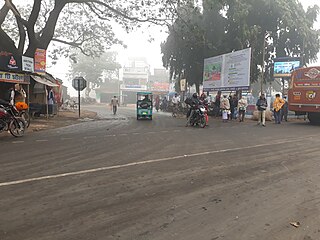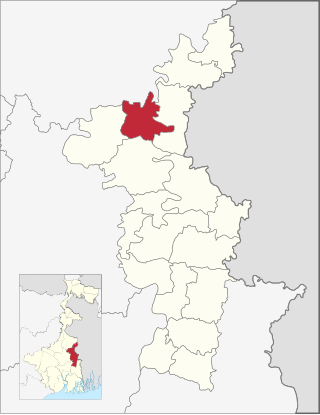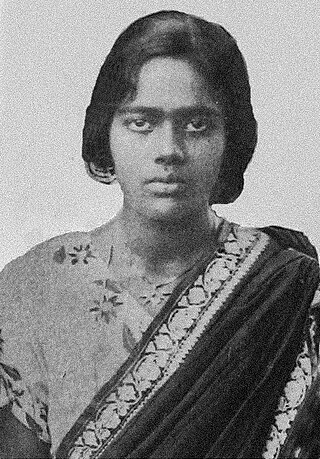Related Research Articles

The Salt march, also known as the Salt Satyagraha, Dandi March, and the Dandi Satyagraha, was an act of nonviolent civil disobedience in colonial India, led by Mahatma Gandhi. The 24-day march lasted from 12 March 1930 to 6 April 1930 as a direct action campaign of tax resistance and nonviolent protest against the British salt monopoly. Another reason for this march was that the Civil Disobedience Movement needed a strong inauguration that would inspire more people to follow Gandhi's example. Gandhi started this march with 78 of his trusted volunteers. The march spanned 387 kilometres (240 mi), from Sabarmati Ashram to Dandi, which was called Navsari at that time. Growing numbers of Indians joined them along the way. When Gandhi broke the British Raj salt laws at 8:30 am on 6 April 1930, it sparked large-scale acts of civil disobedience against the salt laws by millions of Indians.

Nadia is a district in the state of West Bengal, India. It borders Bangladesh to the east, North 24 Parganas and Hooghly districts to the south, Purba Bardhaman to the west, and Murshidabad to the north.

Tehatta is the headquarters of the Tehatta subdivision in Nadia district in the Indian state of West Bengal. The place is a sub-divisions in the district of Nadia. It was declared as sub-division in 1996. Tehatta is located beside the India-Bangladesh border area.

Matangini Hazra was an Indian revolutionary who participated in the Indian independence movement. She was leading one of the five batches of volunteers, constituted by the Samar Parisad, at Tamluk to capture the Tamluk Police Station on 29 September 1942, when she was shot dead by the British Indian police in front of the Police Station, becoming the first "Quit India" movement martyr in Midnapore. She was a staunch Gandhian and was fondly called as Gandhi buri, Bengali for "old lady Gandhi".
Mahishya is a Bengali Hindu traditionally agrarian caste, and formed the largest caste in undivided Bengal. Mahisyas were, and still are, extremely diverse caste consisting of all possible classes in terms of material conditions and ranks.

Tehatta II is a community development block that forms an administrative division in Tehatta subdivision of Nadia district in the Indian state of West Bengal.

Harchand Singh Longowal was the President of the Akali Dal during the Punjab insurgency of the 1980. He had signed the Punjab accord, also known as the Rajiv-Longowal Accord along with Rajiv Gandhi on 24 July 1985. The government accepted most of the demands of Akali Dal who in turn agreed to withdraw their agitation. Less than a month after signing the Punjab accord, Sant Longowal was assassinated by Gyan Singh Leel and Jarnail Singh Halvara.

Tehatta subdivision is an administrative subdivision of the Nadia district in the state of West Bengal, India.

Karimpur II is a community development block that forms an administrative division in Tehatta subdivision of Nadia district in the Indian state of West Bengal.

Tehatta I is a community development block that forms an administrative division in Tehatta subdivision of Nadia district in the Indian state of West Bengal.

Pritilata Waddedar was a Bengali revolutionary nationalist who was influential in the Indian independence movement. After completing her education in Chattogram and Dhaka, she attended Bethune College in Kolkata. She graduated in philosophy with distinction and became a school teacher. She is praised as "Bengal's first woman martyr".
Debnathpur is a village under the Tehatta subdivision of the Nadia district in the Indian state of West Bengal. It belongs to the community development block of Tehatta I.

Palashipara, is a village in the Tehatta II CD block in Tehatta subdivision of the Nadia district, West Bengal, India.
Hogalbaria is a village in the Karimpur I CD block in the Tehatta subdivision of the Nadia district in the state of West Bengal, India. The village is situated near the Indo-Bangladesh border.

Suniti Choudhury was an Indian nationalist who, along with Santi Ghose, assassinated a British district magistrate when she was 14 years old and is known for her participation in an armed revolutionary struggle.

Anantahari Mitra was a Bengali Indian independence movement activist.
Biswanath Sardar was a leader of the Indigo revolt in the Bengal. He was popularly known as Bishe Dakaat.

Pradyut Kumar Bhattacharya was a Bengali revolutionary and activist of the Indian freedom movement. He was hanged in Midnapore Central jail.
Chanderghat is a village under the Tehatta subdivision of the Nadia district in the Indian state of West Bengal. It belongs to Tehatta I CD block. The village situated near the border of Bangladesh and India besides the Jalangi river. District headquarters Krishnagar is the nearest town and railway station to Chanderghat which is approximately 45 km away.

Bimal Dasgupta, nicknamed "Makhan", was an Indian revolutionary and member of the Bengal Volunteers who carried out assassinations against British colonial officials in an attempt to secure Indian independence.
References
- 1 2 Vol - I, Subodh C. Sengupta & Anjali Basu (2002). Sansab Bangali Charitavidhan (Bengali). Kolkata: Sahitya Sansad. p. 549. ISBN 81-85626-65-0.
- ↑ Swadhinata Sangramer Itihas Rachana Samiti (1973). Swadhinata Sangrame Nadia. Krishnagar: Nadia Jela Nagorik Parishad. p. 345.
- ↑ VOL.I, P. N. CHOPRA (1969). Who's Who of Indian Martyrs. ISBN 9788123021805 . Retrieved 17 March 2018.
- ↑ "SCHOOL DETAILS OF SAHID SATISH SARDAR PRY SCHOOL". wbsed.gov.in. Retrieved 17 March 2018.